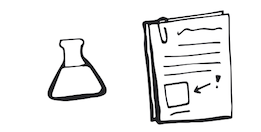Outdoor air pollution, in the most extreme cases, can be immediately identified even without any special training. It casts a haze over cities, collects on streets and buildings, and provides dramatic fodder for the news. But while high drama is often a prerequisite for news about air quality to be reported, the real story is the health impacts that occur even when the air isn't thick enough to see. **What is air pollution and who’s affected by it?** Some common outdoor air pollutants are largely invisible gases, such as ground-level ozone, nitrogen dioxide, and volatile organic compounds. Other pollutants, such as particulate matter, are made up of solid particles and liquid droplets mixing in the air. Several pollutants can combine to make more familiar and obvious forms of air pollution, like smog. The sources of air pollution are varied, ranging from motor vehicle exhaust to wildfires to petrochemical plants. And the presence of pollutants in the air changes over space and time. Unhealthy air has the potential to affect anyone, but people who live and work closest to major sources of air pollution experience the most severe health impacts. Outdoor air pollution and its effects on the human body cause over 4 million deaths a year worldwide [1], with fine particulate matter alone leading to more than 3.2 million premature deaths [2]. In October 2013, the World Health Organization [announced](http://www.iarc.fr/en/media-centre/iarcnews/pdf/pr221_E.pdf) they are considering particulate matter, a major component of both outdoor and [indoor air](https://publiclab.org/wiki/indoor-air-quality) pollution, as a Group 1 carcinogen along with tobacco smoke and asbestos. This page is a place to collect and organize resources on investigating air pollution. Visit the [air quality tag page](https://publiclab.org/tag/air-quality) to see the latest community posts about air quality on Public Lab, and get updates on this topic by subscribing: Subscribe to air quality Sources: [1] [WHO resources on ambient air pollution](https://www.who.int/health-topics/air-pollution#tab=tab_2). [2] [Brauer et al. 2012](https://doi.org/10.1021/es2025752). _Lead image from @eustatic's [work](/notes/Schroyer/11-23-2013/measure-coarse-and-fine-air-particulates-with-a-dustduino#c7711)_ On this page you can: See community stories and projects on air quality Join the conversation Ask a question, answer a question, or follow future questions on air quality Post an issue brief that describes your local concern related to air quality Research air quality Find resources to get started with community air monitoring Decide what pollutants to monitor Learn about common air pollutants and monitoring methods Do or add an activity Learn about regulations, policies, and advocacy related to air quality Find further reading and resources on air quality See what’s still unknown and next step challenges in air quality monitoring ## Community stories and projects [](/i/42019?s=o) Image: [@mollydanielsson](https://publiclab.org/profile/mollydanielsson) _How have different communities approached their local air quality concerns?_ ### Air quality projects Public Lab community projects tagged with `air-quality-projects` will appear here [wikis:air-quality-projects] ### Particle sensor projects Public Lab has initiated a [Particle Sensing Project](/wiki/particle-sensing) focused primarily on [silica](/wiki/silica). This project overlaps with and includes the DustDuino and is coordinated on the [Air-Quality Google Group](/lists). A variety of particle sensors have been posted on the site: [wikis:particle-sensor] Do you have a project or story to share? Start a project page or write a blog post and add the tag air-quality-projects, or post links here! ### More community projects and stories + **[Remembering Tonawanda](https://publiclab.org/notes/kgradow1/07-01-2020/remembering-tonawanda)**: Public Lab blog post by @kgradow1 and @jjcreedon on the incredible organizing and community science for cleaner air in Tonawanda, New York. + **South Durban Community Environmental Alliance (SDCEA)**: on [this page](https://publiclab.org/notes/A_SCH/11-08-2020/mobilizing-action-through-community-science-draft#South+Durban,+South+Africa), you’ll find videos of Desmond D'sa describing how [SDCEA](https://sdcea.co.za/)’s community organizing around bucket air monitors gave rise to new air quality legislation in South Africa. + **[Community Observation Networks for Air (CONA)](https://cona-nz.blogspot.com/)**: out of New Zealand, @guolivar is building and using lower-cost air sensors to monitor local air quality and engage communities in air quality research. + **[Modeling Environmental Health Impacts of I-10 to Engage Residents and Decision Makers](https://thrivingearthexchange.org/project/claiborne-new-orleans-la/)**: out of New Orleans, Louisiana, this project with the Thriving Earth Exchange included air monitoring with low-cost sensors to connect environmental data and health impacts near the high-traffic I-10 corridor. + **[Breathe Project](https://breatheproject.org/)**: brings together people who work on and are impacted by air pollution to research and map air quality in Allegheny County, Pennsylvania, and beyond. + **[Imperial IVAN](https://ivan-imperial.org/)**: out of Imperial Valley, California, this community-based monitoring network and its successful organizing were the model for [state legislation](https://ww2.arb.ca.gov/capp) aiming to reduce air pollution in the most impacted communities. ### Latest community stories + Community groups in St. James Parish, Louisiana, are making gains in preventing a proposed Formosa plastics plant from operating and doubling toxic air emissions in the area. + “[Appeal Challenges Louisiana’s Air Permits for Formosa Plastics’ Massive Petrochemical Complex in Cancer Alley](https://biologicaldiversity.org/w/news/press-releases/appeal-challenges-formosa-plastics-air-permits-in-louisiana-2020-02-14/)” + “[Judge delays crucial permit for Formosa plastics plant; requires deeper analysis of racial impacts](https://www.theadvocate.com/baton_rouge/news/article_8b2e3284-29d8-11eb-9442-6f8b45c7fcb1.html)” ## Join the conversation [](/i/42020?s=o) Image: [@mollydanielsson](https://publiclab.org/profile/mollydanielsson) ### Questions from the community + See if other community members are asking questions like yours + Ask a question so other community members can offer support + Sign up below to be notified when someone asks an air quality question [questions:air-quality] ### Post an Issue Brief Share a local concern or issue about air quality and get support from the Public Lab community by writing and posting an Issue Brief. Visit “[Write an Issue Brief](https://publiclab.org/wiki/issue-brief)” to find information on what an issue brief is, see examples, and learn how to write one. ## Research air quality [](/i/42021?s=o) Image: [@mollydanielsson](https://publiclab.org/profile/mollydanielsson) Planning and carrying out a community air quality study can seem daunting. Be reassured that many other community groups have planned and done air quality studies, and that the Public Lab community is here to support you. At any time, you can [ask questions](https://publiclab.org/wiki/air-quality#Questions+from+the+community), start an [issue brief ](https://publiclab.org/wiki/air-quality#Post+an+Issue+Brief)with any amount of information you have, or start [documenting your project](https://publiclab.org/wiki/projects), and gather input from other Public Lab members. ### Getting ready Here are some resources that might help you get started with a community air monitoring project. **Posts about gathering with community** [nodes:grid:community-meeting] **See how other communities have investigated their local air** Many community groups have studied local air quality in their neighborhoods and shared their extensive knowledge and experiences in publicly-available written guides. @kgradow1 has compiled a handy **[short list of community air guides here](https://publiclab.org/notes/kgradow1/09-09-2020/a-short-list-of-community-air-guides)**, and explained the advantages and limitations of each guide. Much of the more general guidance on this page was collected from these community air guides. A particularly comprehensive how-to guide is the _[Guidebook for Developing a Community Air Monitoring Network: Steps, Lessons, and Recommendations from the Imperial County Community Air Monitoring Project](https://trackingcalifornia.org/cms/file/imperial-air-project/guidebook)._ It covers community engagement, choosing tools and software, determining monitoring sites, and analyzing data. ### Deciding what to monitor Some of the main factors that will affect how you monitor air quality: The pollutant of interest and where you’ll monitor it Your air monitoring goals: what you want to do with your data Below are some resources that can help you answer these questions #### What pollutants might be in the air near you? Considering common sources of air pollutants can help you determine which pollutants might be in your community. **_General sources_**: the buttons below list some examples of human activities, industries, and natural sources. Click the buttons to see common air pollutants these sources use or produce. Oil and gas operations, power plants Oil and gas production, refining, storage; oil- and coal-fired power plants Volatile organic compounds (VOCs); “BTEX” VOCs benzene, toluene, ethylbenzene, and xylene, especially associated with natural gas; formaldehyde associated with natural gas compressor stations Methane Sulfur compounds Nitrogen oxides (NOx) Particulate matter (PM) Polycyclic aromatic hydrocarbons (PAHs) Manufacturing facilities Chemical manufacturing, commercial manufacturing, petrochemical plants Volatile organic compounds (VOCs), especially ethylene oxide, benzene, formaldehyde Nitrogen oxides (NOx) Polycyclic aromatic hydrocarbons (PAHs) Construction and mining Dust / particulate matter Polycyclic aromatic hydrocarbons (PAHs) Urban environments Exhaust from gas-powered motor vehicles; municipal waste sites Particulate matter Volatile organic compounds (VOCs), especially ethylene, propylene, and acetylene Nitrogen oxides Sulfur dioxide Carbon monoxide Methane Agricultural activity Ammonia Hydrogen sulfide Nitrogen oxides Natural events: Wildfires, volcanoes Wildfires: fine particulate matter (PM2.5) Volcanic activity: sulfur dioxide and particulate matter, making volcanic smog (“vog”) **_Sources near you_**: the activities listed below can help you learn about searching public databases to find out what industries and emissions sources are near you. [notes:grid:activity:air-database] After you narrow down your pollutants of interest, you can read more about them and the range of methods to investigate the pollution below in the "[Air pollutants and monitoring methods](https://publiclab.org/wiki/air-quality#Air+pollutants+and+monitoring+methods)" section. ##### How can air pollutants impact your health? You might choose a specific pollutant to monitor because you know it’s in your local air and you’re experiencing health impacts. **[ToxFAQs](https://www.atsdr.cdc.gov/toxfaqs/index.asp)** by the Agency for Toxic Substances and Disease Registry (ATSDR) in the US contains a large alphabetical list of compounds, how you might be exposed to each, and their potential health impacts. **[Toxic City: Health Impacts of Chemicals Emitted in the South Durban Area](https://publiclab.org/notes/kgradow1/11-06-2020/toxic-city-health-impacts-of-chemicals-emitted-in-the-south-durban-area)**: this guide by the South Durban Community Environmental Alliance (SDCEA) refers to specific companies in the South Durban area of South Africa, but the industry types, emissions, and health impacts can be applicable to anywhere. If there aren’t specific pollutants you’re looking for and you’re more interested in detecting what’s in the air, you can do broad spectrum sampling. #### What are your study goals? Determining what you **ultimately want to do with air quality data** will help guide the approach you take and what kind of data will best answer your questions. Some example goals: + Create community awareness of an air quality issue + Identify pollution hotspots for more monitoring + Share information on an air quality issue with media + Submit data to a regulatory agency In general, using data for regulatory or legal purposes will require certain methods to collect the data and meeting set data quality standards. **Posts about planning an environmental study** + [Start an environmental monitoring study](https://publiclab.org/wiki/start-enviro-monitor-study) + [Strategizing around an air quality issue](https://publiclab.org/wiki/frac-sand-action-oriented-resources#Strategizing): this particular page is about frac sand but could be applied to other air quality issues ### Air pollutants and monitoring methods Based on your initial observations and research on what sources of air pollution are near you, you have an idea of which air pollutants you want to investigate. **What methods are available to study them?** You might be able to use [existing public databases](https://publiclab.org/notes/bhamster/11-30-2020/comparing-air-quality-databases-a-fun-activity) to meet your study goals, or you might decide to collect your own air monitoring data. Below are resources for gathering your own data on air quality. #### Overview of common approaches ODOR LOGGING Many air pollutants have a distinctive smell Government agencies often have odor complaint hotlines Recent posts on odor logging Image from Odor Log 1.0 VISUAL MONITORING Visible emissions of airborne particulate matter Training and certification available Image from Smoke School SENSORS Detect pollutants continuously, outputs in real-time Various ways to detect different pollutants: metal oxide sensors, electrochemical, light-scattering/optical Some sensors can detect both gases and particulate matter, others have more specificity Trade-offs with real-time monitoring and data collected Recent posts on air sensors Image from @warren SAMPLING For gases, capturing an air sample in a container for further analysis by an air testing lab Colorimetric samplers use reactive surfaces that indicate pollutant exposure by changing color Various other methods for dust sampling and particulate matter sampling, including filter-based methods Recent posts on air sampling Image from @kgradow1 For another way to view different air monitoring approaches, check out the box entitled, **“What other kinds of community air monitoring are there?”** on pg. 12 of the _[Guidebook for Developing a Community Air Monitoring Network](https://trackingcalifornia.org/cms/file/imperial-air-project/guidebook)_. It outlines different approaches that vary in mobility and timeframes, including fenceline monitoring, grab sampling, personal monitoring, and mobile monitoring. #### Gases **[Air polluting gases and monitoring methods](https://publiclab.org/wiki/air-polluting-gases-and-monitoring-methods)**: on this wiki page we describe some main approaches to monitor gas-phase air pollutants, and then list **common outdoor gaseous pollutants** (e.g., volatile organic compounds (VOCs), nitrogen oxides, ground-level ozone, carbon monoxide, and hydrogen sulfide) and **examples of tools** to detect and measure them. Visit and edit the page to help grow this resource! One of the tools listed for sampling gas-phase air pollutants that has a storied history in community campaigns is the **[Bucket Monitor](https://publiclab.org/wiki/bucket-monitor)**. On the linked wiki page, you’ll find information on how people have been using the bucket monitor to advocate for change, plus updated resources on building and using a bucket monitor. You can also find a kit to build your own bucket monitor in the Public Lab store. #### Particulate matter (PM) **[Introduction to Particulate Matter](https://publiclab.org/wiki/pm)**: find **community questions** and **research notes** about particulate matter, plus a deep dive into different kinds and sizes of PM. **[Collecting data on particulate matter](https://publiclab.org/wiki/pm-monitoring)**: kicks off with key resources on strategizing your **monitoring efforts to match with your community goals**, then describes different monitoring methods including regulatory methods and Smoke School for communities. **[Choosing a method for Particulate Matter Monitoring](https://publiclab.org/wiki/choosing-a-method-for-particulate-matter-monitoring)**: goes deeper into different PM monitoring approaches (visual, filter-based, optical, passive) to help you choose the method right for you. For each approach, it describes **advantages and disadvantages**, **when it might be useful**, and **example tools**. One of the more accessible tools for monitoring PM that also helps you [understand how some sensors work](https://publiclab.org/notes/stevie/05-20-2019/exploring-with-the-simple-air-sensor) is the **[Simple Air Sensor](https://publiclab.org/wiki/simple-air-sensor)**. Developed by Public Lab, it’s an open-source, optical sensor-based tool that signals changing PM levels in your air with a colored LED light. #### Tools for mapping and viewing data + **[Real-time Geospatial Data Viewer (RETIGO)](https://www.epa.gov/hesc/real-time-geospatial-data-viewer-retigo)** + A tool by the US EPA to map and view your own sensor data + [Question: Has anyone used EPA's RETIGO to upload air quality data?](https://publiclab.org/questions/liz/01-14-2019/has-anyone-used-epa-s-retigo-to-upload-air-quality-data) #### Air quality subtopics A collection of wiki pages on monitoring methods and approaches covering particulate matter and gases [wikis:parent:air-quality] #### Activities Activities on Public Lab that have been tagged with `air-quality` will appear here [activities:air-quality] ## Regulations, policy, and advocacy ### US Environmental Protection Agency standards and regulations #### National Ambient Air Quality Standards (NAAQS) _**What are the standards?**_ Section 109 of the **Clean Air Act** directs the EPA to establish **National Ambient Air Quality Standards (NAAQS)** requisite to _protect public health_ with an adequate margin of safety (primary standard) and _for the protection of public welfare_ (secondary standard). The standards are for six common pollutants, referred to as [criteria air pollutants](https://www.epa.gov/criteria-air-pollutants): ground-level ozone, particulate matter, nitrogen dioxide, sulfur dioxide, carbon monoxide, and lead. Section 109(d)(1) of the Clean Air Act requires EPA to complete a thorough review of the NAAQS at 5-year intervals and enact new standards when appropriate. The standard levels are listed in the summary table below and can also be [found here](https://www.epa.gov/criteria-air-pollutants/naaqs-table). [](https://i.publiclab.org/system/images/photos/000/005/670/original/EPANAAQS.gif) _**How are the air quality standards enforced?**_ States and tribes use air monitoring data and models on the criteria pollutants to evaluate whether they meet the NAAQs. They send their evaluation information to the EPA, which then [designates an area as attainment or nonattainment](https://www.epa.gov/criteria-air-pollutants/naaqs-designations-process) for the pollutant standard. Nonattainment areas must [create and carry out a plan for attaining standards](https://www.epa.gov/criteria-air-pollutants/naaqs-implementation-process) by reducing emissions. Complete details of the standards, measurement principles, and data interpretation, can be found in [Title 40 of the Code of Federal Regulations Part 50](http://www.ecfr.gov/cgi-bin/text-idx?tpl=/ecfrbrowse/Title40/40cfr50_main_02.tpl). _**EPA Test Methods**_ EPA approved instruments are designated as either a Federal Reference Method (FRM) or Federal Equivalent Methods (FEM). The complete list of approved instruments for evaluating NAAQS is provided on the EPA [Ambient Monitoring Technology Information Center (AMTIC) website](http://www.epa.gov/ttn/amtic/criteria.html). #### Hazardous air pollutants / air toxics In addition to the six criteria air pollutants, the Clean Air Act requires the EPA to regulate 187 [hazardous air pollutants](https://www.epa.gov/haps) (also known as air toxics). These [pollutants](https://www.epa.gov/haps/initial-list-hazardous-air-pollutants-modifications) can cause serious health effects, such as cancer, even at low levels. ### State and local regulations **[Community Air Protection Program](https://ww2.arb.ca.gov/capp)** - California AB 617: addressing inequities in air quality and monitoring, California is implementing the Community Air Protection Program to “...reduce exposure in communities most impacted by air pollution.” + The impacts of this 2017 bill are yet to be seen--let’s update here as they become apparent + Potential pros: puts more air quality monitoring at the local level; aims to connect air quality to health outcomes and remediation efforts + Questions and potential challenges: will limited funding and capacity make communities compete with one another for resources? How exactly will polluting facilities be held accountable? **Example Air Pollution Regulations in Wisconsin** | VIOLATIONS | RELEVANT PROVISION | |-|-| | Air pollution which is defined as the presence of smoke, dust, gases, fumes in the air. The presence of these substances must also lead to injury on humans, animals or plants as well as interfere with the enjoyment of life or one's property. | NR 400.02 | | Fugitive dust. This refers to the presence in the air of dust from sources such as open fields and piles. There will be a violation on air quality when during handling, transporting and storing of materials, the people undertaking these activities do not take precaution and some of these materials end up being released into the air. | NR 415.04| | Causing, allowing or permitting solid or liquid hazardous substances into the air. This includes dust, soot, pollen, smoke and liquid droplets. One can spot that violation by simply observing the ambient air. | NR. 415.05| | Industrial sand mines that do not take precautions to ensure dust does not escape into the air. | NR 415.075| ### International regulations + [European Union Ambient Air Quality Directive](https://ec.europa.eu/environment/air/quality/index.htm) ### Other resources for air quality standards + The US Center for Disease Control (CDC) and its **National Institute for Occupational Safety and Health (NIOSH)** also offer a wealth of guidance. In particular, the [NIOSH Manual of Analytical Methods](http://www.cdc.gov/niosh/docs/2003-154/) is a collection of procedures for sampling and analysis of contaminants including workplace air. + The **Agency for Toxic Substances and Disease Registry (ATSDR)**, based in Atlanta, Georgia, is a federal public health agency of the U.S. Department of Health and Human Services. Their [Toxicological Profiles](http://www.atsdr.cdc.gov/toxprofiles/index.asp#P) are particularly useful for when a pollutant can be identified by compound or element. + Correlating environmental monitoring with health monitoring: the article, “[New Voices, New Approaches: Drowning in Data](https://issues.org/ottinger/#.X9JdJukpqrk.link),” by Gwen Ottinger and Rachel Zurer outlines some of the limitations with relying on air quality standards alone. **Community posts and pages on air quality regulations** [nodes:air-quality-regulations] ### Advocacy [](/i/42022?s=o) Image: [@mollydanielsson](https://publiclab.org/profile/mollydanielsson) _How can we use air monitoring data, either gathered from public databases or collected ourselves, to advocate for healthier air? To fill in information gaps left by regulatory agencies?_ In the [Community stories and projects](https://publiclab.org/wiki/air-quality#Community+stories+and+projects) section above, you’ll find examples of how community groups have advocated for changes to air quality policy. **In general, how can people take action with community-sourced air quality data?** + Not all communities can or need to collect air quality data comparable to regulatory monitor data. + [Citizen Science Programs at Environmental Agencies: Best Practices](https://www.epa.gov/sites/production/files/2020-11/documents/citizen_science_programs_at_environmental_agencies_best_practices.pdf) - this guide from the Environmental Law Institute suggests **practices to ensure that community-sourced data can be used effectively for a range of purposes**. For example: >"Data used for policy or enforcement decisions must be highly accurate, whereas data that is used for screening or exposure may be moderately reliable since these assessments will be investigated further by the agency.” + [This table](https://publiclab.org/wiki/pm-monitoring#Proposed+precision+categories+for+citizen+monitoring) from the EPA’s [Air Sensor Guidebook](https://www.epa.gov/air-sensor-toolbox/how-use-air-sensors-air-sensor-guidebook) matches different kinds of monitoring goals with some suggested goals for how precise and complete the air monitoring data should aim to be. + [Citizen Science Programs at Environmental Agencies: Case Studies](https://www.epa.gov/sites/production/files/2020-11/documents/citizen_science_programs_at_environmental_agencies_case_studies.pdf) - this partner guide to the “Best Practices” guide above from the Environmental Law Institute offers case studies of successful community science and government partnerships. Air quality case studies start on pg. 5. **Community posts about general advocacy pathways** [nodes:advocacy-pathways] ## Further reading and resources + [Statistics for Action air quality resources](https://sfa.terc.edu/using/options/air.html): includes links to an air quality guide, plus activities to help people understand and apply environmental data. + “[How has the US fracking boom affected air pollution in shale areas?](https://theconversation.com/how-has-the-us-fracking-boom-affected-air-pollution-in-shale-areas-66190)”: article by Gunnar Schade explaining how air pollution is rising in places where fracked oil and gas wells abound. + [Polluter’s Paradise](https://www.propublica.org/series/polluters-paradise): an award-winning series of stories from Louisiana on the petrochemical industry and its environmental impacts in the region. + [EPA Air Pollution Monitoring for Communities grants](https://www.epa.gov/air-research/air-pollution-monitoring-communities-grants): funded partnerships between research institutions and community groups to study air sensor technology. + [Environmental Sensor Data Repository](https://esdr.cmucreatelab.org/) from the CREATE Lab at Carnegie Mellon University: open source data from a large network of environmental sensors reporting on pollutants including particulate matter, total volatile organic compounds, and carbon monoxide. ### Real Time Data EPA and its State and Tribal partners publish near real-time air quality data (typically hourly updates) as well air quality _forecasts_ on the [AirNow web site](http://airnow.gov/). The AirNow site also contains, links to [Air Quality Webcams](https://www.airnow.gov/resources/web-cams/), which are yet another way to evaluate air pollution. Examples of clear and hazy days from [Boston HazeCam](https://hazecam.net/camsite.aspx?site=boston): [](https://i.publiclab.org/system/images/photos/000/005/671/original/boston.jpg) ### Historical Data Historical air quality test results are freely available through [EPA AirData](http://www.epa.gov/airdata/) ### Wikis All wiki pages related to air quality [wikis:air-quality] ## Next step challenges + Step-by-step guides on how to use existing databases to find out what air emissions and polluting facilities are nearby in a community. + Clear steps on how to use and find patterns in raw air quality data, including publicly-accessible existing data or data measured by community scientists. + Improving accuracy in lower-cost sensors for VOCs and air toxics. + Testing the accuracy of currently available low-cost VOC sensors. + Encouraging government agencies to act on low-cost sensor data: e.g., defined pathways for community scientists to influence decision-making that isn’t limited to collecting research-grade data. ...